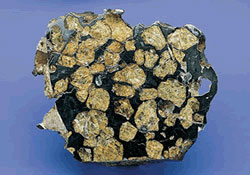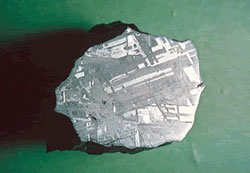Chapter 15. Meteoroids, Meteors, and Meteorites
15.1 Introduction

Author: Kristen Miller
Editor: Grace L. Deming, University of Maryland

Image courtesy of NASA
The goals of this module: After completing this exercise, you should be able to:
- Describe the relationship between meteoroids, meteors, and meteorites.
- Describe the different types of meteorites.
In this module you will explore:
- How the Widmanstatten pattern sheds light on the origin of asteroids.
- What carbonaceous meteorites can teach us about the early solar system.
Why you are doing it: A lot of debris, much of it too small to easily detect with a telescope, was leftover after the formation of our solar system. As these meteoroids fall towards the Earth, we first view them in a spectacular display of light as shooting stars, and then later, if anything survives, we find them in the form of meteorites. Meteorites are one of the few components of the solar system that we are able to study up close. Existing in a variety of compositions, they offer a unique view into the early, formative stages of our solar system.
15.2 Background

Our solar system is littered with debris - remnants left over from the formation period that were massive enough to avoid being blown away by the solar wind. These chunks of debris, although insignificant in size and mass compared to the planets, can produce spectacular, and sometimes destructive results when they intersect our orbit and enter the Earth's atmosphere. Though rare, meteoroid collisions with the Earth are memorable events in recorded history!
The dent in the trunk of the car shown on the right was made by a 27 pound meteorite which passed through the Earth's atmosphere and crashed into Michelle Knapp's car in 1992. Luckily, no one was in the car when it was hit! Although the meteorite damage wasn't covered by insurance, Ms. Knapp sold the football sized meteorite for a reported $69,000.

In 1954, Mrs. Hodges of Sylacauga, Alabama was hit in the hip by an 8 pound meteorite as she lay sleeping on her couch. The first picture on the right shows Mrs. Hodges holding the meteorite underneath the spot where it crashed through her roof; with her in the picture are the town mayor and police chief. The second picture shows the bruise caused by the meteorite.
Besides being destructive, meteorites (and the meteoroids from which they originate) are interesting objects that contain clues to conditions in the early solar system. In this activity, you will explore meteoroids in depth and discover what they can teach us.
15.3 Meteoroids, Meteors, and Meteorites
Before we delve into the composition and characteristics of meteorites, we need to understand the relationship between meteoroids, meteors, and meteorites, as shown in the animation below. Click on 'Next' to begin.
Question Sequence
Question 15.1
u68F9KPsYSrVKA1GziA01XY+Oe1aw/be0wpyN0F5Kc4+aX8UWeVZzTCp795ryTBt0t8S5OJAdBNYJfEw4iwegwzGwGGzzAJh2uviBmQWL49v4R98ezjgHToBkq1yxiJZ4XU2DY8yhGj1Vz0wc0oECBKrahwjlqgj5OK8sdNjDL2wZokOQuestion 15.2
zlb6Yt1WAcYs5Jphg78VnDSjtX24uFYIkkPPJbFhlAJhaVegnsn/j2A81OUprz6BQkKCWr12cgZtvf0vxh/K8caVcurahj+369xZyJk1J534vRgd7WdkJ10M9SDOW1qOmP1lisQf0P1dRjMkpygH2NBNQbXTxa/lZ6PeWrr+cW0G5qtjrl5WoVK0XKtYrHJ/s7T3DvffmiLj+eIvbkLOc8I9hS6/KiLUYQvZZbs4z06ZdVFqgC8/lA2PUOiEn3+hr/YgjDyudJxhJX0HTo7B7Fbz7iT0vuN8hBQXoW4k6/qrLAfO4wkDW3NWTSck3SdipBGWzFXhlhYUBK84WbCXMMKz9anU7MDNDH2LSg1sRsFViLOXFcWEgGBfz0ZsqTeSMkXRsTDejrU6cAsRyiS/aeFz9xEUqXZf5v8tzk2w1IQ+q93zQDASwEpJdLtL6A9S1EFhgJZl3WLyhYJCOycSlKU/Ruw=Summary
A meteoroid is an irregularly shaped chunk of rock, just like an asteroid but smaller, moving through space as it orbits the Sun. Typically, rocks with diameters larger than 50 m (just over 15 feet) are classified as asteroids, and those smaller are classified as meteoroids. The distinction is based on size, not composition or characteristics of the rocks. If a meteoroid travels in an orbit that intersects the Earth's, it may eventually collide with the Earth, entering our atmosphere. As the meteoroid travels through the atmosphere, it glows due to frictional heating. This glow creates the flash of light known as a meteor (or shooting star, as meteors are commonly called). The heat generated as the meteor travels through the air not only creates a glow, but also causes the meteor to disintegrate. If some small fragment of the original meteoroid survives and makes it to the ground, it is called a meteorite.
15.4 Types of Meteorites

The true significance of meteoroids is that they are one of the few celestial objects that can easily be studied firsthand and up close here on Earth. Such studies indicate that there are three main types of meteorites: stony, stony iron, and iron.

Stony meteorites are the most common; about 95% of all meteorites are classified as stony. These meteorites are much like ordinary rocks on Earth, but they contain tiny iron flecks and are often coated with a fusion crust. The crust forms due to high levels of heating as the meteor travels through the Earth's atmosphere, which melts the outer layers of the meteorite. The stony meteorite shown in the figure to the right has a fusion crust.

Stony iron meteorites account for only 1% of all meteorites. These meteorites contain equal amounts of iron and stone and are the most beautiful when cut and polished as in the figure to the right.

About 4% of all meteorites are classified as irons as shown in the figure to the right. These usually contain no stone at all, but may have 10-20% nickel mixed in with the iron. The interior of the majority of iron meteorites is distinguished by a particular nickel-iron crystalline structure known as a Widmanstatten pattern. The last figure to the right shows this pattern. Note the distinctive interlocking crystals - this is the Widmanstatten pattern.
Question 15.3
TEm+OmzPjaksdgOmMmKgbXuuemKYFlM3ccx8NdpVSPB8WsWcXlZWLuBQjr4xdYhPNLay6V6FU8tEJQwqDzGL5iFPWetPm9+mQy6kDPjCE5sxfGkZ0igFsRzXrJlGqJKdMI2IJj+Kca5Pv8VG7OlOJZVWe/pX82MObr03SJp3G3wUWA10XUTV7CNmiPGBF0siafFSIOh3Z3xP7xbjRudRu7GabD87BvzP7HN5tbOCsfzy7pwla/as1dX3awtntLNl/RB4sIEXKNTtyZrFMvvGBLepKsfiEEN0PICBHEA55hguLyzPIQumbcRZRSV0lPRYLCLQ0peokuXLbzO+OokoT+FJw0T7u6wpjBVkpEGAyGE=15.5 The Widmanstatten Pattern
The Widmanstatten pattern is formed when a mixture of nickel and iron becomes molten and then cools very slowly over a period of millions of years. This pattern is interesting for two reasons: first, because it distinguishes iron meteorites from ordinary Earth rocks composed of iron, allowing scientists to easily determine a meteorite's authenticity; and second, because it provides a clue to the origin of most asteroids in our Solar System.
Scientists believe that most meteoroids were once part of asteroids large enough to have remained in a molten state for much of their formation period. Let's consider one such asteroid. As it formed, decay of short-lived radioactive isotopes could have heated its interior to high enough temperature to melt rock. If it was large enough, the asteroid would have lost this heat very slowly, allowing its interior to remain molten for several millions of years. Because its interior was molten over a long period of time, such an asteroid would have undergone chemical differentiation, which means that denser components like nickel and iron would have sunk to its center while less dense components like rock would have risen to the surface. After it cooled, collisions with other asteroids could have caused it to break apart. Pieces of its crust would then naturally form stony meteoroids and pieces of its core would form iron meteoroids, with stony irons forming from intermediate regions. This is illustrated in the following animation; click on the start button to begin.
The Widmanstatten pattern provides observational evidence in support of this theory by establishing that iron meteoroids were initially molten and cooled very slowly.
Question 15.4
6p1y66gSjtVyZ/w5+jxvwJHHvcyvaR28u5qUpnlnHot6XmEMzfQ4NTPWmwQtJ81etwL2O4ldCBeHIys8CreDxZV5NGo5ONbOaS9jQ2kUa7U7h2eERMKK3Fh5zFStTqZJPFQjl0oTF2d3ALAaTGv4ldayjPdVT5sOkZX/Jg5eQt0=15.6 Carbonaceous Chondrites

The theory presented on the previous page can explain the origin of most meteorites, but there are some stony meteorites that show no sign of melting or of differentiation. These meteorites, known as carbonaceous chondrites, must be fragments of undifferentiated asteroids. They are significant because their interiors contain primordial material and have remained unchanged since they formed during the early days of the solar system. Their compositions therefore are representative of the composition of the nebula from which the Sun and planets formed. Studying these meteorites tells us about conditions in the early solar system and about the material from which our planet formed.
Carbonaceous chondrites contain substantial amounts of carbon and carbon compounds, organic molecules including amino acids, water, and other minerals.
Question 15.5
mt5rHlso/BPuLuMAa7gSbLV18RJSQiKC1Hau94AxUAgUicsb5I+f7g+kv+Lro79HHML1u2qsdK14+zE5EV77F1colEhHgR7xWywp3juiDKip1l6cBCtr/MRwjyAtgYaO0rNibyZVrZ5t72lyQz/r6w==Summary
Carbon is a basic building block of life, and the main component of organic molecules. It is interesting to note that two ingredients necessary for life to start: "water and amino acids" were present in the early solar system and would have been part of the material from which the Earth formed. By studying meteorites such as carbonaceous chondrites, astronomers can take a glimpse back in time to the period when our solar system first formed and find out under what conditions our Earth, and possibly life on it, originated.
15.7 Quick Check Quiz
Indepth Activity: Meteoroids, Meteors, and Meteorites